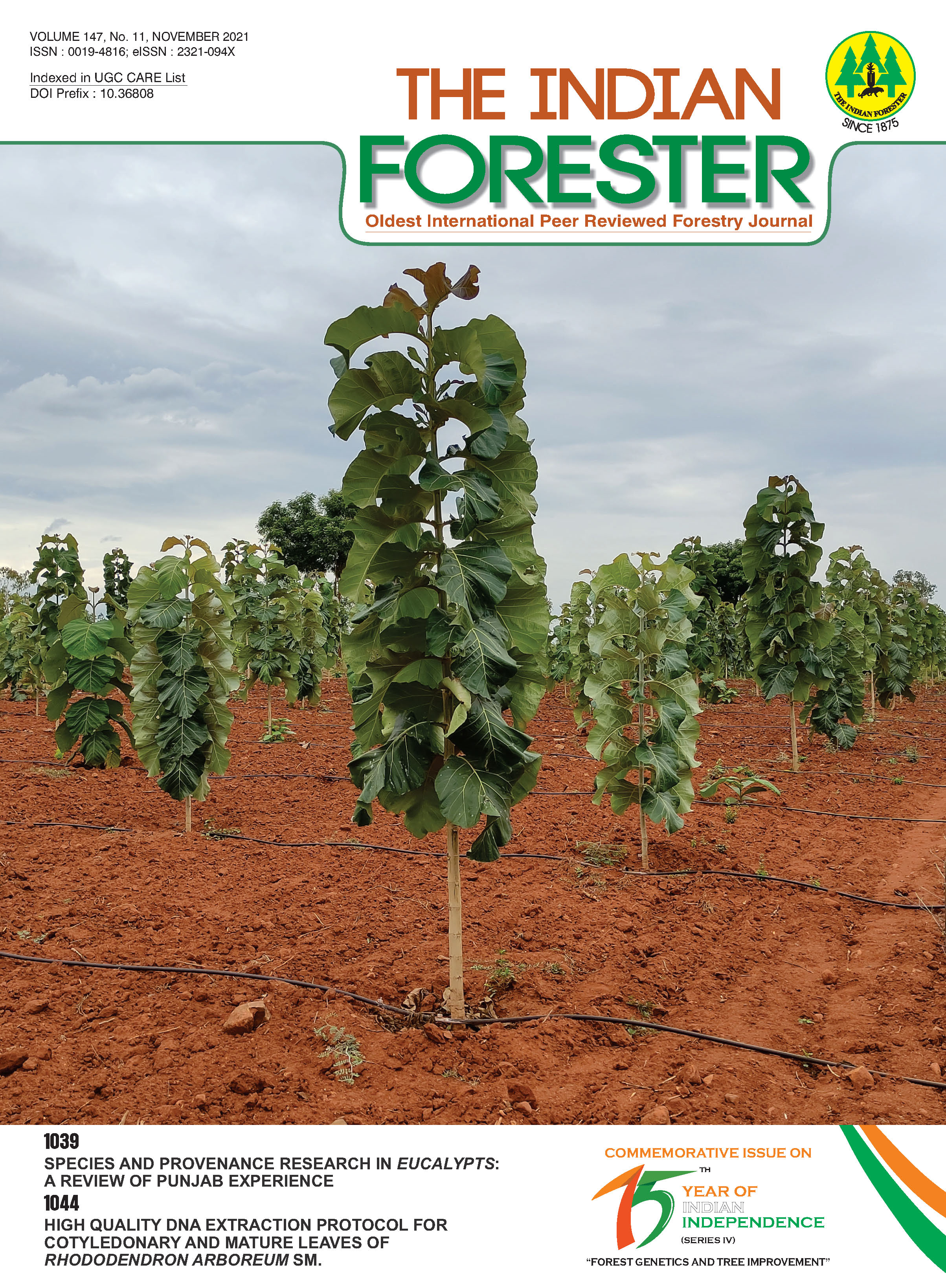Assessment of Variations in Growth, Bark thickness and Heartwood Content of Different Populations of Redsanders (Pterocarpus santalinus) in Karnataka
DOI:
https://doi.org/10.36808/if/2021/v147i11/155680Keywords:
Redsanders, Variation, Growth, Heartwood, Age, Plantation, Pterocarpus.Abstract
Red sanders is one of the highly valued tree species in the world, native to south parts of Eastern Ghats (Andhra Pradesh and Tamil Nadu). As the success of any tree improvement depends upon the amount of variations found in heritable traits of populations and is basis for future genetic improvement, the present study was carried out to assess the variations in growth traits, bark, sap- and heartwood of different populations of red sanders in Karnataka. Hullikere (43 years), K.Settihalli (47 years), Jharakabande (32 years), Nallal (42 years), Yeshwanpur -A (42 years) and Yeshwanpur-B (42 years) in Karnataka. Significant variability found in growth traits viz., girth, straightness, tree height and sap- and heartwood content of the Red sanders. Time of heartwood formation varies within and between trees as well as between the populations. Both content and colour of heartwood vary even in the trees of same girth in a stand. No heartwood was found in trees which had girth <37, <41, <44, <46 and <48cm at breast height in Jharakabande, Hullikere and Yeshwanpur-B, Yeshwanpur A, Nallal and K.Settihalli plantations, respectively. The heartwood formation was not depicted any trend with tree size and age of trees in the Redsanders populations.
References
Arunkumar A.N. (2011). Variability studies in Pterocarpus santalinus in different aged plantations of Karnataka, My Forest, 47(4): 343-353.
Bamber R.K. and Fukazawa K. (1985). Sapwood and heartwood, A review. For. Abstr., 46: 567-580Pp.
Bowell E.C, Maguire D.A., Briggs D.G and Turnblom E.C. (2014). Effects of silviculture and genetics on branch/knot attributes of coastal Pacific Northwest Douglas-fir and implications for wood quality-a synthesis, Forests, 5: 1717-1736.
Chaturvedi A.N. and Khanna L.S. (1994). Forest mensuration. International Book Distributor, Dehradun. 403 p.
Das D.K. (2013). Working Plan of Mandya (2011-12 to 202122), Karnataka Forest Department, Govt. of Karnataka.
Foster G.S. and Shaw D.V. (1988). Using clonal replicates to explore genetic variation in a perennial plant species, Theor. Appl. Genet., 76: 788-794.
Hegde V., M.D.S. Chandran and M. Gadgil. (1998). Variation in bark thickness in a tropical forest community of Western Ghats in India, Functional Ecology, 12, 313-318
Hillis W.E. (1987). Heartwood and Tree Exudates, Springer Verlag, Berlin pg. 268.
IFGTB. (2016). A Study on Comparison of Natural and Plantation Grown Red Sanders Wood, Indian Council of Forestry Research and Education, Dehradun, Uttarakhand, 45p.
Iqbal Muhammad Zafar, Amber Khan, Muhammad Shafiq, Mohammad Athar, Zia-ur-Rehman Farooqi and Muhammad
Kabir (2016). Tree Size Comparison of Some Important Street Trees Growing at Different Sites of Karachi City, Pakistan, J. Appl. Sci. Environ. Manage, 20(2): 453 - 461.
Kesavaraju R. and Jagdishwararao R. (1991). Distribution of Red sanders among geological formations in Cuddapah landscape, Indian Journal of Forestry, 10: 264-266.
Knapic Sofia, Tavares Fátima and Helena Pereira (2006). Heartwood and sapwood variation in Acacia melanoxylon R. Br. trees in Portugal, An International Journal of Forest Research, 79(4): 371-380.
Kuehne C., Peter Nosho, Tobias Horwath and Jurgen Bauhus (2014). A comparative study of physiological and morphological seedling traits associated with shade tolerance in introduced red oak (Quercus rubra) and native hardwood tree species in southwestern Germany, Tree Physiology, 34(2): 184-193.
Nabeshima E., T. Kubo and T. Hiura (2010). Variation in tree diameter growth in response to the weather conditions and tree size in deciduous broadleaved trees. Forest Ecol. Manage., 259(6): 1055- 1066.
Pérez Cordero L.D. and Kanninen M. (2003). Heartwood, sapwood and bark content, and wood dry density of young and mature teak (Tectona grandis) trees grown in Costa Rica, Silva Fennica, 37(1): 45-54.
Rajan Lakshmy J., S. Suresh Ramanan, E.V. Anoop (2019). Physical and Anatomical - wood properties variation among the provenances of Red Sanders (Pterocarpus santalinus), Indian Journal of Hill Farming, 32(1): 162-168.
Romberger J.A., Hejnowicz Z. and Hill J.F. (1992). Plant Structure: Function and Development. Springer-Verlag, Berlin.
Saha Somidh, Christian Kuehne and Jürgen Bauhus (2014). Intraand interspecific competition differently influence growth and stem quality of young oaks (Quercus robur L. and Quercus petraea (Mattuschka) Liebl.), Annals of Forest Science, 71(3): 381-393.
Sivashankar Reddy C. (1982). Note on red sanders, Appendix No. 35, Management plan, Kadapa District (1982 to 1997), AP Forest department, Govt. of AP.
Sotelo Montes C.R., Hernadez E., Beaulieu J. and Weber J.C. (2006). Genetic variation and correlations between growth and wood density of Calycophyllum spruceanum at an early age in the Peruvian Amazon, Silvae. Genet., 55(4- 5): 217-228.
Suresh K., Maheshwar Hegde, Deenathayalan P., Karthick Kumar M., Thangapandi B., Gurudev Singh and Krishnakumar N. (2015). Variation in heartwood formation and wood density in plantation grown Red Sanders (Pterocarpus santalinus) International Conference on 'Wood is Good: Current Trends and Future Prospects in Wood Utilization', organized by the Institute of Wood Science and Technology, Bang Purkayastha S.K. (1996). A manual of Indian timbers, Sribhumi Publishing Company, Calcutta, India, pp. 251.
Taylor A.M., Gartner B.L. and Morrell J.J. (2002). Heartwood formation and natural durability - a review, Wood Fiber Sci., 34: 587-611.
Troup R.S. (1921). The Silviculture of Indian trees I, Claredon Press, Oxford, 235p.
Whitmore T.C. (1984). Tropical Rain Forests of the Far East, 2nd edn. Clarendon Press, Oxford.
Downloads
Downloads
Additional Files
Published
How to Cite
Issue
Section
License
Unless otherwise stated, copyright or similar rights in all materials presented on the site, including graphical images, are owned by Indian Forester.





